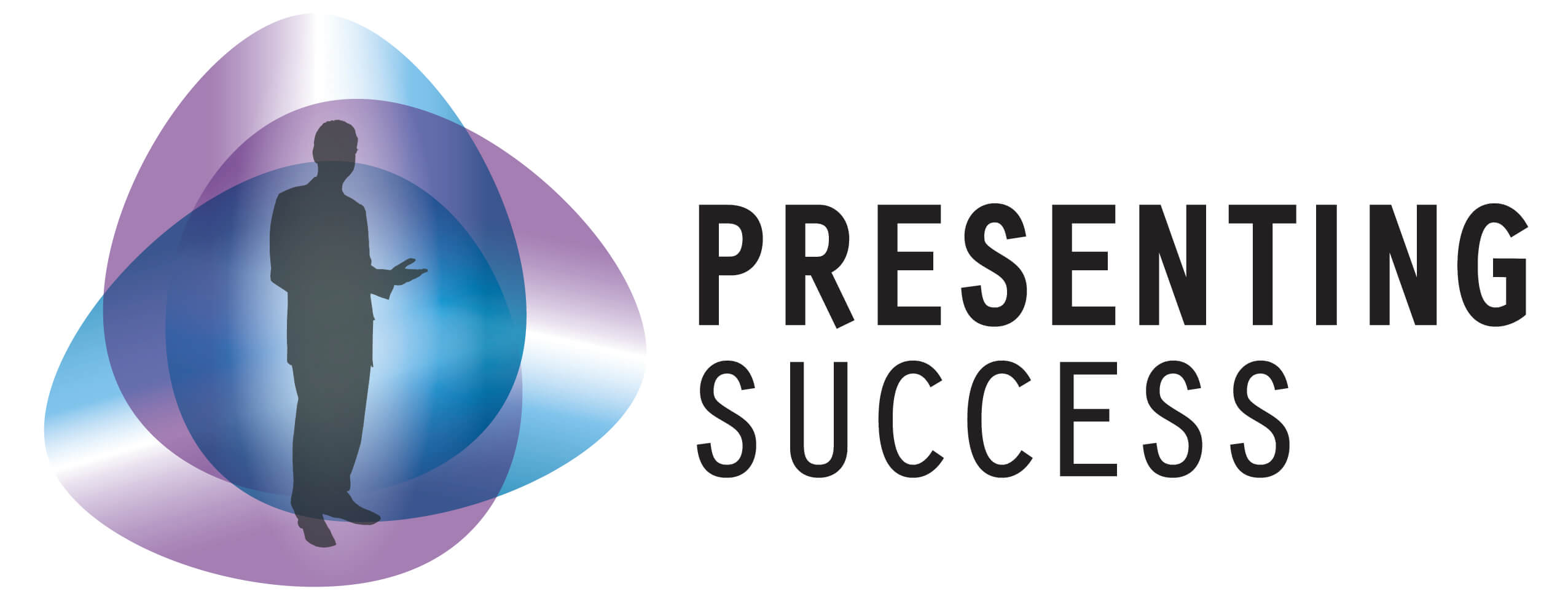First impressions "How should i open my presentation?" is a question we get asked often.…

How can I give a successful online presentation?
Here’s my advice on how to give a successful online presentation:
There are three challenges to presenting online:
- having an interesting and relevant presentation,
- engaging your audience, and
- managing the technology.
With good awareness of these areas and good preparation you will be able to give a successful online presentation.
Online it’s much harder for you to read your audience whether they’re attentive and interested, or not. There will be distractions for them, such as email or what’s happening around them at home or in the office: you won’t have their attention in the same way as if you were standing in front of them.
So to give a successful online presentation it will need to be more engaging; it will need to be more interesting visually, and you will need to use your voice and energy well.
Prepare Your Presentation Well

The same principles apply to online presentations as to stand-up presentations. My suggestion is that you ask yourself our 3 key questions as you start your preparation:
- Who is my audience?
- What is my point?
- How long have I got for the presentation?
These are covered in detail in another blog.
Using these questions do your groundwork preparation for what you want to cover, including stories, examples, facts and points. Then you can think about how to deliver that online, remembering that it needs to be interesting and visually stimulating.
Be clear what you’re saying, and what you want the audience to know, to do or to think. Know your audience; what is it that they want or need, or are expecting? What is it that you want to give them?
Prepare for a shorter time than you have been given, as more time may be taken up with introductions and other interactions, depending on the group size. Much better to cover less material in some depth than try to cover a lot and overrun your time. With an audience of busy people you’ll lose some credibility if you run over your time.
Make Your Presentation Engaging
If you want to give a successful presentation online, you will need to bring your points ‘alive’ in some way, so that as you go through your presentation, your audience members are saying, ‘I get it’. There are lots of ways of doing this. For example, you could dramatise them in some way; tell some short stories; give lots of examples that the audience can relate to; ask them to think about their own situation; or show interesting graphics or photos that grab people’s attention.
Get on with it!
You will need to get into the substance of the presentation quickly in order to grab your audience’s attention and interest. Using some variation of the KICK opening will be a good place to start (this also is covered in another blog).
Engage your audience

Online you can use polls to canvas the audience’s opinions. Or you could ask more questions, maybe with multiple answers so that it’s easy for them to answer, maybe inviting them to pop their answers in the chat box, with a ‘y’ for yes or an ‘n’ for no.
If you ask questions, it will take longer to get people’s responses than if you were face-to-face: allow for that. And, if you are looking for input from your audience, you will need to ask them individually for their contributions – just asking an open question, such “as does anyone have a comment?” will probably not produce the reply that you’re looking for.
Or you could have one or more short conversations about your topic with a particular (volunteer?) member of the audience. You will need to be confident that you can handle the interaction and, be aware that it will use up time quite quickly; you will be less in control of the time if you ask others to speak, unless you are very familiar with facilitating online.
Depending on your purpose, you could put them in small groups into break-out rooms to discuss your topic. You will need to be very clear what question or point you’re looking for them to consider; how long they will have for the discussion; and how they will report back.
Make it interesting to look at

You’ll want your slides, or whatever visual aids you’re using, to be interesting. You don’t have to use PowerPoint or similar; you could use just A4 sheets printed out; or no visual aids at all. If you’re going to use slides, the basic principles of slide preparation apply: use pictures where possible; use colour; and use much fewer words, and in a bigger font, than you’ll probably initially feel comfortable with. Be bold with your visuals.
You could use a whiteboard or a flipchart behind or beside you, as you develop your ideas. This will be more interesting for the audience than more PowerPoint slides, but you will need to practice drawing and writing on the board. If you do decide to do that, please make sure you have pens that work. Choose pens of strong colours, with a broad tip so your audience can easily see what you’re drawing/writing.
You may choose to use a short video; but be careful. We’re now so used to videos that an audience will only watch for about 15 or 20 seconds, unless it’s very interesting and engaging. Do get a second opinion from a colleague whether the video you plan to use will convey the message you want to get across.
Managing the Technology
Sounding good!
The quality of your sound is crucial in giving a successful presentation online. The better the sound, the better the audience’s experience of listening to you. Probably just using your computer’s microphone will not be good enough; if your sound is poor they will switch off. If your presentation is important to you, invest in a good microphone, but you don’t need to spend hundreds of pounds or dollars; you can buy a good wired-headset at a very reasonable price.

Looking good!
How you look on camera is important. If you have a modern laptop then the computer’s camera will probably be good enough. If not you’ll need to get a separate webcam, but often paying more attention to your lighting will cure the problem.
The best light is daylight. If you can, position your camera so that you’re facing the window. If you can’t do that, then you’ll need a light in front of you. Don’t have a strong light, such as a window behind you. If you have no choice, close the curtains or get a blind. But usually, better lighting will cure a problem with the camera. You can buy a special online lighting kit at a very reasonable price.
It’s behind you!
Watch your background; what’s behind you? It doesn’t need to be an empty space but a lot of clutter or mess will send a signal to your audience about your ability to get organised. Your audience will look at what’s behind you; what message do you want to send, and do you want them to be distracted? Or you may choose to use a ‘green screen’ which is simply a sheet of green material against which your computer will project a scene which you can choose (the software for this comes with the screen). Again, this is not expensive to buy and it doesn’t have to be a fancy as this one!

Where to look?
Position your camera so that it’s at your eye level or just above. If you have your camera too low, it looks as though we’re looking up at you, from under your chin! Position yourself so that your eyes are in the top half of screen. Don’t get too close to your camera; your head should not fill the screen.
Look at your camera; not at the screen; otherwise your audience just see you looking down the whole time. Don’t sway backwards and forwards, or side to side; it’s distracting.
How good do you look?
You may not want to wear full business dress, but do look as though you’ve made an effort. And that includes the bottom half, in case you need to put the cat out or shut the door while you’re online. Avoid wearing clothes that have either checks or stripes, as both will not show up well on camera. And if you’re using a green screen you’ll not want to wear green or you’ll blend in with the background!
If you intend to present using your hands then position yourself so that the audience can see your hands for the whole time. It’s not good practice to have your hands appearing in the screen and then disappearing.
If you’re working from home warn others in the household that you’re on an important call so they don’t interrupt. And have a backup plan for when the 3-year old wanders in.

Get familiar with the technology
Getting very familiar with the technology may take some time, but it’ll be worth it. If you don’t know how to share slides, or mute or unmute people, it will be a distraction from your presentation. Additionally, you may need to help others manage the technology, to help them share slides, or to allow their video to come on. Admitting that you don’t know how to do something will not be impressive or helpful.
If you’re sharing slides, or anything else, have them ready on your desktop, and close down any other applications on the desktop, such as email. Have a backup plan if anything doesn’t work first time. Most audiences will be forgiving most of the time, if you look reasonably competent and well-prepared.
If you’re not sure how any of the technology works, set up a practice first. If you’re using Zoom or Microsoft Teams, for example, try it first with a colleague or family member until you become familiar with it.
Manage your energy
Maintain a good level of energy; be upbeat and full of life! Be clear in your speech; probably speak a little slower, and lower. Have a practice run and record yourself, both the video and the sound; is it good enough? Consciously change your energy; use pauses to allow people to absorb what you’re saying. If you’re unsure how to change your voice or your energy, get in touch with us for some helpful ideas.
Essentially the principles of presenting are the same as if you were standing to present face-to-face to a group: sit or stand strong. Feet flat on the floor; upright posture.
Don’t get upset if you see members of your audience going off camera, or playing with their phones, or seemingly getting distracted. Actually, you don’t know what’s going on for them; they may actually be deeply interested in what you have to say. Note to yourself for next time – make sure you’re more interesting, ask better questions or plan for more audience involvement.
Finally

A good presenter these days will be able to present standing in front of a group, as well as being able to present online. Get used to presenting online; it’s the future for anyone who wants or needs to communicate well with a group. And if you need help with any of this, we’d be delighted to share our experiences with you; you only have to ask.



